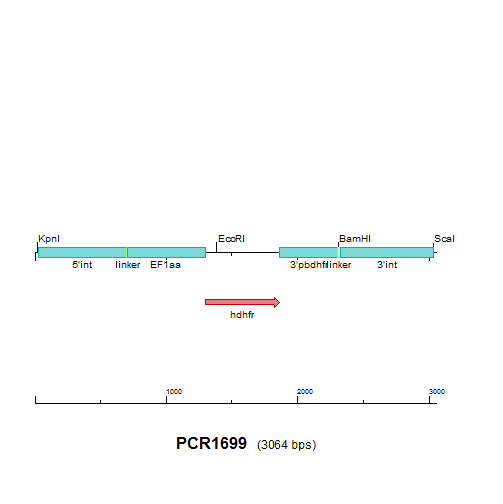SummaryRMgm-827
|
||||||||||
Last modified: 16 August 2013, 18:55
 *RMgm-827
*RMgm-827| Successful modification | The gene/parasite could not be changed/generated by the genetic modification. |
| The following genetic modifications were attempted | Gene disruption |
| Number of attempts to introduce the genetic modification | 2 |
| Reference (PubMed-PMID number) | Not published (yet) |
| top of page | |
| Parent parasite used to introduce the genetic modification | |
| Rodent Malaria Parasite | P. berghei |
| Parent strain/line | P. berghei ANKA |
| Name parent line/clone | P. berghei ANKA 676m1cl1 (RMgm-29) |
| Other information parent line | 676m1cl1 (RMgm-29) is a reference ANKA mutant line which expresses GFP-luciferase under control of a constitutive promoter. This reference line does not contain a drug-selectable marker (PubMed: PMID: 16242190). |
| top of page | |
| Attempts to generate the mutant parasite were performed by | |
| Name PI/Researcher | J. Lin; C.J. Janse; S.M. Khan |
| Name Group/Department | Leiden Malaria Research Group |
| Name Institute | Leiden University Medical Center |
| City | Leiden |
| Country | The Netherlands |
 Disrupted: Mutant parasite with a disrupted gene
Disrupted: Mutant parasite with a disrupted gene| top of page | |||||||||||||||||||||||||
| Details of the target gene | |||||||||||||||||||||||||
| Gene Model of Rodent Parasite | PBANKA_1230700 | ||||||||||||||||||||||||
| Gene Model P. falciparum ortholog | PF3D7_0615900 | ||||||||||||||||||||||||
| Gene product | protein phosphatase, putative | ||||||||||||||||||||||||
| Gene product: Alternative name | |||||||||||||||||||||||||
| top of page | |||||||||||||||||||||||||
| Details of the genetic modification | |||||||||||||||||||||||||
| Inducable system used | No | ||||||||||||||||||||||||
| Additional remarks inducable system | |||||||||||||||||||||||||
| Type of plasmid/construct used | PCR construct double cross-over | ||||||||||||||||||||||||
| PlasmoGEM (Sanger) construct/vector used | No | ||||||||||||||||||||||||
| Modified PlasmoGEM construct/vector used | No | ||||||||||||||||||||||||
| Plasmid/construct map |
 | ||||||||||||||||||||||||
| Plasmid/construct sequence |
  GAACTCGTACTCCTTGGTGACGGGTACCATATATCATTCTACGCATATCCTAAATTTTGC
| ||||||||||||||||||||||||
| Restriction sites to linearize plasmid | |||||||||||||||||||||||||
| Partial or complete disruption of the gene | Complete | ||||||||||||||||||||||||
| Additional remarks partial/complete disruption | |||||||||||||||||||||||||
| Selectable marker used to select the mutant parasite | hdhfr | ||||||||||||||||||||||||
| Promoter of the selectable marker | eef1a | ||||||||||||||||||||||||
| Selection (positive) procedure | pyrimethamine | ||||||||||||||||||||||||
| Selection (negative) procedure | No | ||||||||||||||||||||||||
| Additional remarks genetic modification | The protein contains the following domain: IPR001932 - Protein phosphatase 2C-related (pp2c). Several unsuccessful attempts to disrupt the gene (exp 1782 and 1957 with PCR constructs 1782 and 1957 respectively). The unsuccessful attempts indicate an essential role during blood stage development/multiplication. The locus was unsuccessfully targeted using a linear construct that was generated using a 2-step, anchor tagging PCR method (for primer details see below). The 5’- and 3’ targeting regions of the gene were PCR amplified from genomic DNA using primer pairs 1&2 and 3&4. Primers 2 and 3 have 5’-terminal extensions homologues to the hDHFR selectable marker cassette. Primers 1 and 4 both have a 5’-terminal overhang with an anchor-tag which serves as a primer site in the 2nd PCR reaction. The target fragments from the first PCR reaction were annealed to either side of the selectable marker cassette by PCR with anchor-tag primers 5 and 6, resulting in the 2nd PCR product. The hDHFR selectable marker cassette used in this reaction was digested from pL0040 using restriction enzymes XhoI and NotI. pL0040 is available from The Leiden Malaria Research Group. To remove the anchor-tags from the final KO construct, and to eliminate contaminating pL0040, the 2nd PCR product was digested with Asp718/ScaI and DpnI respectively. DpnI only cuts methylated plasmid DNA but not the PCR product. For a more detailed understanding of the 2-step anchor tagging PCR method, please see the following publications: J.W. Lin, S.M. Khan et al A novel 'gene insertion/marker out' (GIMO) method for transgene expression and gene complementation in rodent malaria parasites PLoS One. 2011;6(12) T. Annoura et al Assessing the adequacy of attenuation of genetically modified malaria parasite vaccine candidates Vaccine. 2012 Mar 30;30(16):2662-70 One more unsuccessful attempt to disrupt the gene was carried out using a second linear construct that was generated using a 2-step, anchor tagging PCR method. This construct (PCR1827) used the same targeting regions but differed by having the hdhfr::yfcu selectable marker cassette. The attempt was made in the WT cl15cy1 background. | ||||||||||||||||||||||||
| Additional remarks selection procedure | |||||||||||||||||||||||||
|
Primer information: Primers used for amplification of the target sequences
 Primer information: Primers used for amplification of the target sequences

| |||||||||||||||||||||||||
| top of page | |||||||||||||||||||||||||

